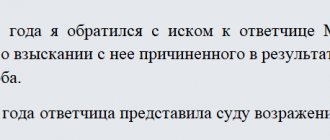The concept of parties in civil proceedings
The parties are the main persons involved in the case;
Without them, the process in the claim proceedings is impossible. Parties to a civil case are persons participating in the case, whose dispute about a subjective right or interest protected by law must be considered by the court.
Otherwise, the parties to a civil case are persons whose civil dispute between them must be resolved by the court.
In accordance with Art. 38 of the Code of Civil Procedure of the Russian Federation, the parties to civil proceedings are:
- plaintiff (person in whose interests the case was initiated);
- defendant (a person whom the plaintiff points out as a violator of his rights and who, as a result, is brought to justice by the court).
The opposing interests of the plaintiff and defendant determine the purpose of their participation in a civil case.
The purpose of the plaintiff’s participation in a civil case:
- protection of your subjective rights and legitimate interests.
The purpose of the defendant’s participation in a civil case:
- protection of his subjective rights and interests from the plaintiff’s unfounded, in his opinion, claims.
The parties enjoy equal procedural rights and bear equal procedural responsibilities.
Thus, the essential features of the parties to civil proceedings should be considered:
- presence of civil interest in resolving the case;
- presence of procedural interest in a decision beneficial to oneself;
- extension to the parties of the substantive force of a court decision;
- bearing legal expenses in accordance with the procedure established by law.
The concept of “parties” in civil procedural law is usually used in a broad sense and applies to persons participating not only in claims proceedings, but also in other cases resolved in civil proceedings. For example, applicants in special proceedings also enjoy the rights of parties. In Art. 263 of the Code of Civil Procedure states that cases of special proceedings are considered and resolved by the court according to the general rules of claim proceedings, taking into account the peculiarities of such cases.
At the time of filing a statement of claim, the court proceeds from the fact that there is a material legal relationship between the plaintiff and the defendant (civil, labor, family, etc.), which has become controversial because the plaintiff believes that it is being challenged or violated by the defendant. Whether there is a substantive legal relationship between the parties, whether the defendant really violates or challenges the rights of the plaintiff, the court will have to find out during the trial.
More details
For a process to occur, there must be two parties - the plaintiff and the defendant - with opposing interests. The process cannot arise if the plaintiff, when submitting an application to the court, did not indicate a specific violator of his rights. And if, when the process has begun, one of the parties drops out (for example, in the event of death) and succession in the case is impossible, then the process is terminated.
Since the plaintiff approaches the defendant with a substantive claim, and the defendant must either reject it or admit it, the parties have a substantive interest in the case. Such interest is the first and essential feature that distinguishes the parties from other participants in the process.
In this regard, the court can extend the substantive force of a court decision only to the parties. Indirectly, a court decision can affect the rights of third parties, but directly and directly it obliges and authorizes the parties to perform certain actions (for example, receiving material benefits).
The main task of the court is to consider and resolve the merits of a civil dispute between the parties, to protect their subjective rights and legitimate interests.
In addition, when administering justice, the parties are required to bear appropriate legal costs.
Distributive actions of the parties
Distributive actions of the parties mean that any person interested in the outcome of the case can independently decide on the disposal of the procedural rights available to him. The legislation provides for a certain list of actions that a particular person can perform during the trial. The plaintiff can count on a change in the basis or subject of the claim, on an increase or, on the contrary, a decrease in his stated requirements. In addition, the plaintiff may express a desire to abandon the statement of claim in full or in part. The two parties taking part in the consideration of the case can end it by concluding a special document - a settlement agreement.
Legal status of the parties in civil proceedings
The parties may conduct the case in person or through representatives and are entitled to reimbursement of legal costs under certain conditions.
The parties, having broad procedural rights, are obliged to use them in good faith, as stated in Art. 35 Code of Civil Procedure.
Rights of parties in civil proceedings
In accordance with Art. 35 of the Code of Civil Procedure of the Russian Federation, persons participating in the case have the right:
- get acquainted with the case materials, make extracts from them, make copies;
- challenge;
- present evidence and participate in its research;
- ask questions to other persons participating in the case, witnesses, experts and specialists;
- file petitions, including requests for evidence;
- give explanations to the court orally and in writing;
- present your arguments on all issues arising during the trial, object to the requests and arguments of other persons participating in the case;
- receive copies of court decisions, including receiving, using the Internet information and telecommunications network, copies of court decisions made in the form of electronic documents, as well as notices, summonses and other documents (copies thereof) in electronic form;
- appeal court decisions and use other procedural rights provided by the legislation on civil proceedings.
Responsibilities of parties in civil proceedings
Persons participating in the case bear procedural obligations established by the Code of Civil Procedure of the Russian Federation and other federal laws. Failure to fulfill procedural obligations entails consequences provided for by the legislation on civil proceedings.
The parties, as a rule, voluntarily fulfill their obligations, but the procedural law also provides the court with a certain means of influencing a person who uses his procedural rights in bad faith. For example, if a party files an unfounded claim or dispute against the claim, or systematically opposes the correct and prompt consideration and resolution of the case, the court may recover from it in favor of the other party compensation for the actual loss of time (Article 99 of the Code of Civil Procedure).
The parties to the process also have other responsibilities:
- appear in court (if a party does not appear, then he is obliged to inform the court about the reasons for the failure to appear) (Article 167 of the Code of Civil Procedure);
- bear legal expenses;
- perform certain actions within the procedural time limits provided for by law or established by the court, etc.
Replacing an improper defendant in civil proceedings
The correct identification of the appropriate parties in the process is of great practical importance, as it ensures the legality of the decision made. The process of verifying the legality of the participation of parties in a civil process is called legitimization of the parties . Legitimate means legal. Sometimes the civil procedural law directly indicates who can apply to the court with a corresponding application (for example, in cases of limiting a citizen’s legal capacity due to alcohol or drug abuse, in cases of declaring a citizen incompetent due to a mental disorder). Such norms may also be contained in other federal laws (for example, the Family Code specifies the circle of persons who have the right to file an application to the court for divorce or recognition of marriage as invalid).
Therefore, it is necessary to take into account that:
- proper party - a person in relation to whom there is an assumption that he is the subject of a controversial legal relationship;
- improper party - a person in relation to whom the assumption that he is the subject of a controversial legal relationship is excluded.
If during the proceedings it is discovered that the right of claim asserted by the plaintiff does not belong to him, then the plaintiff is considered an improper party. In this case, the court will make a decision to reject the claim (the stated requirement).
The Code of Civil Procedure of the Russian Federation provides for the possibility of replacing an improper defendant (Article 41), which can only be done with the consent (or at the request) of the plaintiff when preparing the case or during its trial in the court of first instance. If the plaintiff does not agree to replace the improper defendant with another person, the court considers the case based on the claim. The Code of Civil Procedure does not speak about the possibility of taking the initiative to replace other persons participating in the case.
After replacing an improper defendant with a proper one, the court is obliged to prepare the case again and begin its consideration from the very beginning. The procedural law's indication that after replacing an improper defendant with a proper one, the process must proceed from the very beginning is of fundamental importance. Everything that an improper defendant did in the process cannot have legal significance for the proper defendant. For example, another person’s motives for challenging a judge may be different. The proper defendant has the right to demand verification and examination of all evidence, etc.
Partial or complete refusal of the claim by the plaintiff
The plaintiff's refusal of the claim means:
- the applicant's refusal of his claim against the defendant;
- the applicant's refusal to obtain judicial protection of all his rights.
According to the norms of legislative acts, abandonment of a claim means a unilateral administrative action performed by the plaintiff, caused by various motives. Such motives may include the fact that the defendant voluntarily fulfilled all the demands presented to him, as well as the fact that the applicant recognized the unfoundedness of his demands.
Refusal of a claim can be made either in writing or orally.
If the plaintiff expresses his desire to partially or completely waive all of his stated demands, this decision must be entered into the protocol, after which the plaintiff puts his signature confirming the legality of the actions taken.
Procedural succession in civil proceedings
See also Resolution of the Constitutional Court of the Russian Federation dated November 16, 2018 N 43-P “In the case of verifying the constitutionality of part one of Article 44 of the Civil Procedure Code of the Russian Federation in connection with complaints from citizens A.B. Bolchinsky and B.A. Bolchinsky"
The normative regulation of procedural succession allows for the replacement of a party by a legal successor in the event of its alienation during the trial of property, the claim for the protection of ownership of which is being considered by the court)
The procedural law provides for the possibility of applying legal succession in the event of the departure of one of the parties to a controversial legal relationship (Article 44 of the Code of Civil Procedure).
Procedural succession is the transfer of procedural rights and obligations in a controversial material legal relationship from one person to another who has not previously participated in the case.
Procedural succession is possible in relation not only to the parties, but also to third parties.
The difference between procedural succession and replacement of an improper party:
- the person replacing (legal successor) continues the participation of the person being replaced (legal predecessor) in the process.
Everything that happened in the process before the legal successor entered into it is binding on the latter. If the wrong party is replaced, the process starts all over again.
The departure of a party may occur as a result (Article 44 of the Code of Civil Procedure):
- general (universal) succession:
- inheritance;
- reorganization of a legal entity;
- succession in a separate legal relationship:
- assignment of claims;
- debt transfer and
- in other cases there is a change of persons in obligations.
IMPORTANT! Succession is unacceptable for rights and obligations of a personal nature, and is possible only in disputes of a property nature. In such cases, procedural succession may also arise in relation to third parties.
If the law does not allow succession in material legal relations, then it is not allowed in civil proceedings. For example, legal succession is impossible in claims for the collection of alimony for the maintenance of children or parents, reinstatement at work, eviction due to the impossibility of living together.
Thus, succession in material relations seems to precede procedural succession. When resolving the issue of procedural succession, the court is obliged to suspend the proceedings in the case (Article 215 of the Code of Civil Procedure). This rule emphasizes the possibility of legal succession in relation to third parties making independent claims on the subject of the dispute.
Procedural participation in civil proceedings
Art. 40 of the Code of Civil Procedure provides the opportunity to bring claims against several plaintiffs or several defendants; This situation is called procedural complicity. If there are several plaintiffs in the case, then active complicity is formed. If claims are brought against several defendants, then passive complicity is formed. Sometimes mixed complicity is distinguished, when in one case there are several plaintiffs and several defendants.
Procedural complicity is the participation in one case of several plaintiffs or several defendants, whose interests and demands are not mutually exclusive, i.e. connection of the claim according to the subjects of the process (subjective or subjective connection of the claim).
Presentation by a person of several claims (objective or objective combination of claims). Such a connection does not form procedural complicity.
Types of procedural complicity on a procedural legal basis:
- active (on the plaintiff’s side);
- passive (on the defendant’s side);
- mixed (on the side of both the plaintiff and the defendant).
Types of procedural complicity on a substantive basis:
- mandatory (necessary);
- optional (optional).
Necessary complicity is complicity provided for by law, which requires the mandatory participation of all accomplices in the process. Consideration of the case in the absence of at least one of them is impossible if the division of homogeneous claims is unacceptable (for example, the presence of a common right or debt among the accomplices).
The possibility of optional complicity is allowed by the court, as a rule, for a more economical and expedient consideration of the case (filing a general claim of several people dismissed from work, if the circumstances of their dismissal are identical).
Implementing an increase or decrease in the amount of claims
Arbitration procedural legislation separately identifies a rule on increasing or decreasing claims. In particular, according to the rules of the Arbitration Procedure Code of the Russian Federation, such an increase means the need to increase the amount of the claim for the claim. Accordingly, the increase in the amount of demands cannot in any way be connected with the presentation of additional demands to the defendant that were previously stated in the statement of claim filed by the plaintiff. For example, the plaintiff’s demand for the need to apply property sanctions to the defendant cannot in any way relate to the initial demands for collection of existing debt.
Any additional requirement can be submitted independently.
The plaintiff’s statement, which contains a requirement to amend the statement of claim, must be issued in the form of a petition.






